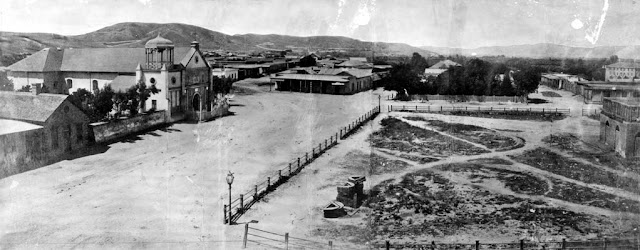The Civil War created a rip in our national fabric and re-wove it with historic change. It resonates to this day, and continues to influence and define how we, as Americans, view ourselves. It is arguably the most traumatic, transformative and talked about event in U.S. History. Despite all the research, all the interest, and all the experts, the American Civil War still has some secrets to reveal. This series will explore a Civil War that you weren't taught about in school...
Prelude to War
The American Civil War was a little less than
two years away. In September of 1859,
what would be known as the Ainsworth-Gentry Affair occurred in San Bernardino,
a far-off dusty town on the edge of tomorrow, a precursor of what would grip
the nation...
Two physicians, Dr. Gentry and Dr. Ainsworth happened to encounter
one another at the Kenniston & Brazelton Stable. Both men held strong public views on the
"national argument", Ainsworth being an abolitionist, while Gentry a
strong supporter of slavery. More than
likely the "heated" discussion ensued, and gunshots were fired. Neither man was hit, but Dr. Thomas Gentry
put out the call to his friends in El Monte for help, under the false pretense
that “he was corralled by Mormons”. One hundred
men, led by Frank Green, set out for San Bernardino. The men from El Monte arrived and Gentry’s
lie was plainly revealed as such. Seeing
this as nothing more than a personal feud between Gentry and Ainsworth, half the
“Monte” boys turned back for Los Angeles.
Ainsworth and his men chose to martial in a old adobe home that was on
a corner, west of the South Methodist Church.
As night fell on the 21st, they left the confines of the
adobe and formed a line of battle in a surrounding cornfield. Under the cover of darkness, Green and his
“Monte” boys drew up a battle line of their own, trying to quietly advance on
the opposing force. Under an extremely
strong defense, Green's men broke, retreating back into the night.
Roundly defeated, the majority of the remaining “Monte” invaders
melted away, leaving only a small core, which included Frank Green, Jim Greenwade,
and two brothers named Sea. Dr. Gentry's
"army" had virtually faded away.
The next day, Gentry was told that his enemy was searching for
him. He and what remained of his
supporters, decided to finish off what was started the night before. Neither party had to wait long. One found the other, and a hail of gunfire
erupted between the warring factions.
David Coopwood, one of Ainsworth’s men, was the only fatality, he being
shot in the thigh by Green. Coopwood's
son would later seek out and murder Green for the death of his father[1].
The town was thrown into a state of complete disarray. Enraged, the few men left from El Monte began
terrorizing the town, using the abolitionists and recent "battles" with
them as an excuse. San Bernardino's
sheriff, “Rube” Herring, was unable to control the lawlessness. A detachment of U.S. Army soldiers were
encamped nearby on the banks of the Santa Ana River, but for some reason were
unable or unwilling to assist in putting down the violence[2]. In desperation, the local citizenry turned
out, armed and ready to fight. Faced
with this threat, the “Monte” vigilantes prudently chose to return home,
judiciously making their way back to Los Angeles. The Battle of San Bernardino, the first
battle of an impending civil war, had ended.
*****
1. History
of San Bernardino County, California, with Illustrations Descriptive of its
Scenery, Farms, Residences, Public Buildings, Factories, Hotels, Business
Houses, Schools, Churches, Etc., from Original Drawings, Including Biographical
Sketches (San Francisco: Wallace W. Elliott & Co., 1883), p. 96
2. History
of San Bernardino County, California, with Illustrations Descriptive of its
Scenery, Farms, Residences, Public Buildings, Factories, Hotels, Business
Houses, Schools, Churches, Etc., from Original Drawings, Including Biographical
Sketches (San Francisco: Wallace W. Elliott & Co., 1883), pp. 95-96,
George William & Helen Pruitt Beattie, Heritage
of the Valley, San Bernardino’s First Century (Oakland: Biobooks, 1951), p.
317, Los Angeles Star (September 17th and 24th,
1859)
